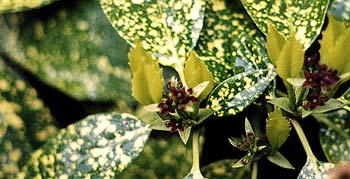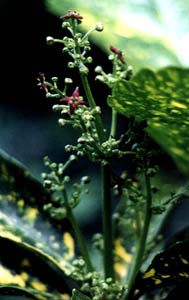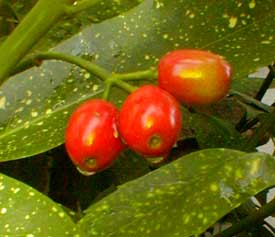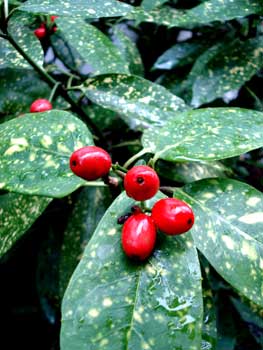
Aucuba japonica,
vibrant evergreen shade shrub
"Now is the time of the illuminated woods,
when every leaf glows like a tiny lamp."
-John Burroughs
(1837-1921)
(1837-1921)
 "Aucuba" (often rendered Acuba) is the latinized Japanese name Aoki, meaning "blue tree," the original unvariegated wild form of this shrub growing to the size of a tree & having blue-great leaves. It is today valued for its array of variegated forms, green & yellow.
"Aucuba" (often rendered Acuba) is the latinized Japanese name Aoki, meaning "blue tree," the original unvariegated wild form of this shrub growing to the size of a tree & having blue-great leaves. It is today valued for its array of variegated forms, green & yellow.We'd had the female Aucuba japonica variegata 'Gold Dust' in the shade corridor for a couple of years, where it grew to about four feet by four feet. It was kind enough to have almost entirely obscured the gas meter.
During its second year it developed one enormous bright red berry, a pathetic performance, but with good reason. Female Aucubas develop few or no berries if there is not a male close by.
Often nurseries give no clue about sexing these shrubs, & all too many don't even realize that gardeners should have at least one male with one or more females for berries to be produced. I did an impromptu survey while trying to find a male. I asked about male shrubs at six different nurseries operated by intelligent people; none even knew off the top of their heads that Aucubas are dioecious (of two sexes), & when I informed them this was the case, none could find out quickly which if any that they were selling, or might special order, were male shrubs.
Though retailers might honestly not know the shrub is dioecious, the growers & distributors appear to be intentionally chary of sharing this information. Big tags on male Aucubas with elaborate information neatly fail to mention that it is male, that it will never fruit, for fear that will spoil the sale. Whereas shoppers reading tags on the female, sold already in full berry, might lose interest if the tag revealed they must also buy a nonfruiting partner to ever see the berries in years to come.
 It can be quite a large shrub & at first I didn't think there was room for a second one, so I was going to forswear the fruits. But I began to miss having big berries that can last all winter & well into spring, so I finally figured out how to get a male into the shade corridor.
It can be quite a large shrub & at first I didn't think there was room for a second one, so I was going to forswear the fruits. But I began to miss having big berries that can last all winter & well into spring, so I finally figured out how to get a male into the shade corridor.The following year the female began producing the extremely colorful berries which are two-thirds of an inch big & round, though on some other varieties they're a full one-inch oblong. The third photo shows some of the berries in January (2005); the fourth photo shows the berries in February (2009).
The male was sold as 'Mister Goldstrike.' By its leaves & general appearance it cannot be distinguished from the female, & the way to sex them is by the flowers. The first photo of 'Gold Dust' shows the eency magenta flowers growing close to the leaves, as is the habit of the female. The second photo is 'Mr. Goldstrike' with the same magenta micro-blossoms, but lifted away from the plant on four inch upright panicles, which is how only the male plants bloom.
It flowers mainly March through April, but occasionally has a second bloom at the beginning of Autumn. The female flower was photographed in April; the male was photographed during a September rebloom. The flowers are way too small to be decoratively important, but they're very pretty at close-in observation, & of course once both sexes are flowering, the tiny flowers on the female will be pollinated then grow into those big bright shiny red balls. These extravagant berries are mildly toxic, as are the leaves, having in them a glyphocide called aucubin.
 Even without the bright fruits, though, Aucuba is one of the most vibrant & colorful evergreens for a shade garden. In temperate zones of Europe & America it has become extremely popular because of the year-round impact; its large leathery variegated leaves have few equals for the darkest corners of gardens. It is disease-free & extremely easy to grow just so long as it is not put in too much sun.
Even without the bright fruits, though, Aucuba is one of the most vibrant & colorful evergreens for a shade garden. In temperate zones of Europe & America it has become extremely popular because of the year-round impact; its large leathery variegated leaves have few equals for the darkest corners of gardens. It is disease-free & extremely easy to grow just so long as it is not put in too much sun.'Gold Dust' with large green leaves flecked with yellow was the first variegated form of Aucuba introduced to western gardening, brought from Japan in 1783 by John Graeffer. Since that long ago time many other cultivars have been developed with larger or smaller berries, with longer or shorter serations of the leaves, with small-spotted leaves or big-blotched leaves, but 'Gold Dust' continues to set the standard by which the success of the others are measured.
'Crotonifolia' has a mix of small & large yellow spots that on some leaves will nearly obliterate the green background. 'Picturata' has a large yellow spot in the middle of each leaf. Other variegated forms include 'Maculata,' 'Golden King,' & 'Golden Spangles.' 'Dentata' is spotted on deeply serated leaves. 'Nana' is a dwarf form. Varieties that more resemble the species are not variegated, such as 'Rotundifolia,' highly compact with shiny green leaves.
Aucuba occasionally grows 8 or 10 feet, & 15 feet is not unheard of. Realistically in most gardens, it will grow slowly to 5 or 6 feet. It can be very carefully pruned to fit a more finite space.